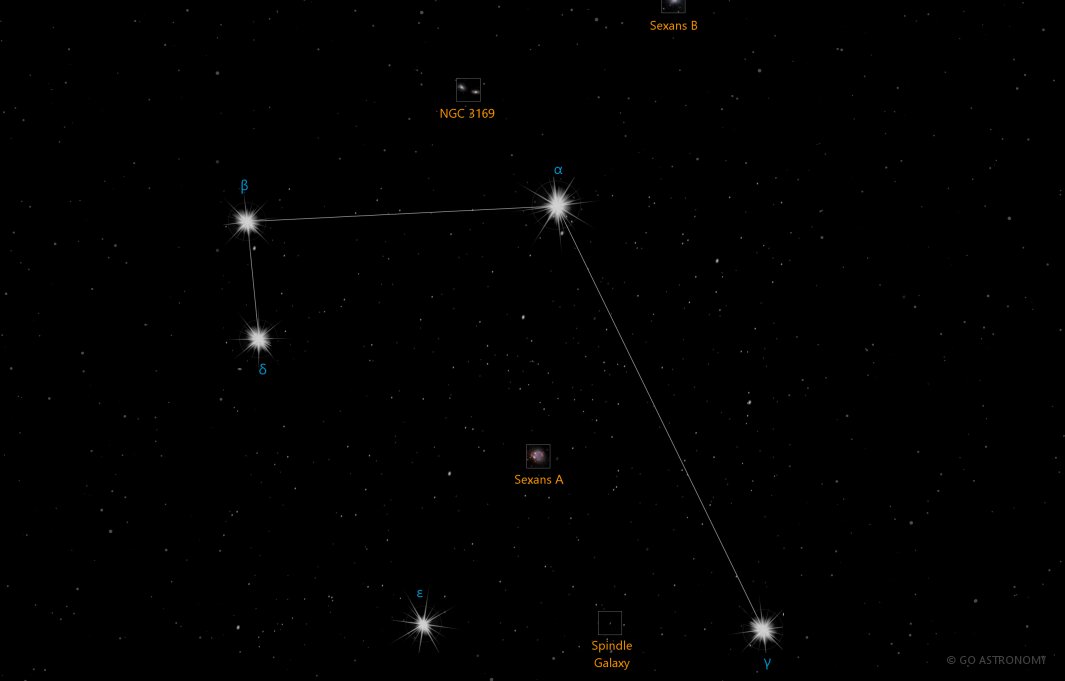Sextans, the Sextant (Sex)
(SEX-tunz)
The Southern constellation of Sextans, the Sextant, is best viewed in Spring during the month of April.
Sextans is the 47th largest constellation. It's brightest star is Alpha Sextantis at magnitude 4.49. The boundary of the Sextans constellation contains 6 stars that host known exoplanets.
Sextans is an equatorial constellation, which means its bulk intersects the celestial equator or comes within 10-15 degrees of doing so. Sextans is visible from most places on Earth.
- Pronunciation:
- SEX-tunz
- Meaning:
- Sextant
- Genitive:
- Sextantis
- Abbreviation:
- Sex
- Constellation Family:
- Hercules
- Hemisphere:
- Southern
- Quadrant:
- SQ2
- Visibility:
- 80° N - 90° S
- Best viewing month*:
- April
- Area:
- 314 sq. degrees
- Size:
- 47th largest
- Equatorial:
- Yes
- Right Ascension (avg):
- 10h 6m
- Declination (avg):
- -3°
- Brightest star:
- Alpha Sextantis (4.49)
- Stars with planets:
- 6
- Messier objects:
- |
Brightest Stars in Sextans
The 10 brightest stars in the constellation Sextans by magnitude.
- Star
- Magnitude
- Spectral class
- Alpha Sextantis (α Sex)
- 4.48
- A0III
- Gamma Sextantis (γ Sex)
- 5.07
- A2V
- Beta Sextantis (β Sex)
- 5.08
- B6V
- Delta Sextantis (δ Sex)
- 5.19
- B9.5V
- Epsilon Sextantis (ε Sex)
- 5.25
- F2III
- HD 90362
- 5.6
- M0.5III
- 18 Sextantis (18 Sex)
- 5.64
- K2III
- HD 84607
- 5.65
- F4IV
- 19 Sextantis (19 Sex)
- 5.77
- K0III:
- 35 Sextantis (35 Sex)
- 5.77
- K3III+
Star Clusters in Sextans
The most notable and easy-to-find star clusters in the constellation Sextans . Also see all star clusters.
Galaxies in Sextans
The most notable galaxies in the constellation Sextans . Also see all galaxies.
- Name
- Alt name
- Type
- Sextans A
- dwarf
- Sextans B
- dwarf
- Baby Boom Galaxy
- starburst
- NGC 3166/3169
- galaxy pair
- Scorpion Galaxy
- galaxy pair
- Spindle Galaxy
- C53
- lenticular
Milky Way Satellites in Sextans
Dwarf satellite galaxies that orbit the Milky Way Galaxy located in the constellation Sextans. Also see all Milky Way satellite galaxies.
- Galaxy name
- Alt name
- Magnitude
- Sextans Dwarf Spheroidal
- 10.4
A Navigational Aid to the Cosmos
Among the 88 official constellations recognized by the International Astronomical Union (IAU), Sextans, named after a navigational instrument, has its own unique place.
Historical Background
Unlike many constellations rooted in ancient mythology, Sextans is a relatively recent addition to the celestial map. It was created in the late 17th century by Polish astronomer Johannes Hevelius. Named after the sextant, a navigational tool used to measure a star's angular distance above the horizon, Sextans serves as a nod to the astronomers' quest for celestial knowledge.
Distinctive Characteristics
Sextans is not the most luminous of constellations - in fact, none of its stars are particularly bright. Its alpha star, Alpha Sextantis, has an apparent magnitude of 4.49, barely visible to the naked eye in optimal viewing conditions. The constellation's relatively dim stars and lack of distinctive patterns make it a challenge to find in the night sky.
Celestial Objects of Interest
Despite its subtlety, Sextans houses a treasure trove of galaxies due to its location away from the Milky Way's plane. Most notably, it is home to the Sextans A and Sextans B dwarf irregular galaxies, both members of our Local Group of galaxies. At a distance of approximately 4.3 and 4.44 million light-years respectively, these galaxies offer a glimpse into cosmic structures beyond our Milky Way.
Another notable object in Sextans is the Black Eye Galaxy (Messier 64). It?s a spiral galaxy distinguished by the dark dust lane and the bright, star-studded nucleus that give it its common name. This galaxy lies at an impressive distance of 17 million light-years from Earth.
Observation
Sextans is best viewed in the spring months for observers in the Northern Hemisphere. It sits between the constellations of Leo to the north and Hydra to the south, which can be used as reference points for locating Sextans.
Given its relatively dim stars, a clear, dark sky, away from city lights and atmospheric pollution, provides the best chance of sighting Sextans. While the constellation's stars can be challenging to see with the naked eye, a small telescope or binoculars will be beneficial for observing its galaxies in more detail.
Sextans may not be the most instantly recognizable constellation in the night sky, but its richness in galaxies provides intriguing observational targets for astronomers. This modest constellation serves as a poignant reminder that sometimes, the quiet and unassuming corners of the cosmos harbor the most fascinating celestial wonders. Whether you are an amateur stargazer or a professional astronomer, the exploration of Sextans offers a celestial adventure that extends far beyond our Milky Way galaxy.
* Constellation shown for northen hemisphere skies. For the southern hemisphere, constellations appear rotated 180 degrees (upside-down and left-right reversed) from what is shown. Remember that seasons are reversed too - summer in northern latitudes is winter in southern latitudes.
** Circumpolar constellations are visible year-round in the hemisphere listed (and not at all in the opposite hemisphere).





